PROBABLY THE BIGGEST ARDUINO BASED MONOME
– January 19th, 2009
Oh yeah!
A 256 buttons Monome in action. I was the other night on Arduino’s IRC channel on Freenode (/join #arduino at irc.freenode.net/8001) when Bastian Chroosposted a video about a 256 buttons Monome. I couldn’t help it so I asked him for some pictures just to check the wiring of that board. Here you can see Bastian’s prototype in action and a picture of the back of his PCBs.
| Video and picture courtesy of Bastian Chroos, (c) 2009 | |
Bastian said that he used:
- 1x Arduino
- 2x 74hc595 (giving voltage to the rows)
- 3x 74hc165 (sampling the columns button states) 1x 8 extra input.. so I
totally get 256+128 buttons..(16 encoders extra and 4 menu buttons are part of the plan)
- 4x MAX7221I did all the code and boards by myself [using Sparkfun parts] but I haven’t implemented everything yet. I just took the basic commands to clearly use the applications.
If you want more information you should look for Chroos on the IRC channel or visit his myspace profile where his music can be found. I got promised some extra pictures soon … neat!
LIBELIUM HACKING CONTEST II
– January 16th, 2009


The guys from Libelium are launching their 2nd Arduino Hacking Contest. Their deadline is April 15th, here I quote Alicia Asin -one of the company owners:
Hi again! In 2008 we promoted the 1st Arduino Open Hardware Contest, which showed (one more time) Arduino boards' big potential (www.arduino.cc). The 2nd Arduino Contest is opened now, we encourage you all to participate! Info and prizes: http://contest.libelium.com Good luck to everyone, we are looking forward to see your hacks /Libelium Team
I gotta post about the devices you can get as prize, since me and Dave got a box of goodies from Libelium as a xmas present. But that will be another day.
WORKSHOPS AT HOME IN COLOMBIA
– December 25th, 2008
I met Alejandro Tamayo in Helsinki in February during Pikselache 2008, besides the Finnish sauna experience -that includes beer drinking and sausage eating half naked on the snow- we share an interest in electronics, education, and working with extremely small groups.
In the past he has been teaching electronics in picnic situations, what is very much in line with the work by the philosopher Sarat Maharaj and his followers at the Un-wetter group. Bringing the educational event outside the classroom and inviting people from outside academia makes the whole experience different, making it into a celebration.
This time, he sent me some pictures where he arranged an Arduino-on-breadboard course at his living room for only four people: a mathematician, a historian, an engineer and a graphic designer. It his his belief that informal teaching models generate special dynamics and bring interesting results.
This is also my understanding about the way hacker culture spreads, through small informal interest groups. If you are part of a community of Arduino users in any size, please remember to use our forum to announce your meetings. There may be many interested/interesting people close to you.
ARDUINO + XKCD
– December 24th, 2008
Arduino’s shown up in some unusual places, but this XKCD cartoon‘s the most random I’ve seen. Thanks Randall for the mention. I think Cory Doctorow is in one of the composite-numbered panels.
WII, IPHONE AND ARDUINO DATE RC CAR
– December 23rd, 2008
Sounds like a strange dinner with the weirdest guests ever, but it is a project from hardcode.tv showing an RC car controlled from different devices where Arduino takes care of hacking the controller. Take a look at their video and enjoy.
FESTIVE ARDUINOS FOR THE HOLIDAYS
– December 16th, 2008
Smart Projects has made a limited run of multi-color Arduino Duemilanoves for the holidays: red, purple, orange, yellow, black, green, white, and of course, blue. Add some color to your holiday Arduino projects, or use them to decorate your workbench. Available in a multi-colored pack from Smart Projects in a limited run.

BIFE ARDUINICO
– December 2nd, 2008
In Argentina I got told to ask for the famous “Bife de Chorizo”, a juicy steak served more or less everywhere. I spent three weeks working with Buenos Aires’ Ministry of Education in promoting the lab-in-a-box project and teaching secondary school educators in the use of open source technologies. We developed interesting examples using a combination of Arduino and Processing.
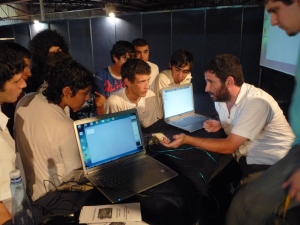
picture courtesy of the Arduino interest group in BsAs
The reaction of the workshop participants to the experience was great, they formed a new technologies interest group that will meet periodically and made some public presentations of the possibilities in teaching using Arduino, as they show in their blog.
The main problem is still importing Arduino boards to Argentina, the import tax is very high for a country which money is worth 25% of the Euro … however if the government is paying, money is not a big deal, and we are talking about 400 schools only in the area of Buenos Aires interested in the use of Arduino. The issue is that the components making an Arduino board what it is are also hard to find there (or non-existing). We need one or more Argentinian distributors as soon as possible!
Other relevant links I could gather during this trip are related to open source software/contents:
- solar.org.ar: one of the open source/free software associations in Argentina
- fmlatribu.com: La Tribu is a radio channel in Buenos Aires that is very concerned about the use of open source and that provides endless hours of copyleft music, both online and on the waves. Also they celebtrated a festivalwhile I was there
- linuxmil.com.ar: the Argentinian military turning to Linux, finally someone taking care of homeland security understands that the penguin offers better level of security than the others
PROCESSING 1.0
– November 25th, 2008
I will just paste here Reas’ and Fry’s announcement of Processing 1.0, finally the official release of the best open source IDE to learn about programming.
Congratulations Processing! Visit their website here
////////////////////////////////
Today, on November 24, 2008, we launch the 1.0 version of the Processing
software. Processing is a programming language, development environment,
and online community that since 2001 has promoted software literacy
within the visual arts. Initially created to serve as a software
sketchbook and to teach fundamentals of computer programming within a
visual context, Processing quickly developed into a tool for creating
finished professional work as well.
software. Processing is a programming language, development environment,
and online community that since 2001 has promoted software literacy
within the visual arts. Initially created to serve as a software
sketchbook and to teach fundamentals of computer programming within a
visual context, Processing quickly developed into a tool for creating
finished professional work as well.
Processing is a free, open source alternative to proprietary software
tools with expensive licenses, making it accessible to schools and
individual students.
tools with expensive licenses, making it accessible to schools and
individual students.
[...]
Students at hundreds of schools around the world use Processing for
classes ranging from middle school math education to undergraduate
programming courses to graduate fine arts studios.
classes ranging from middle school math education to undergraduate
programming courses to graduate fine arts studios.
[...]
Tens of thousands of companies, artists, designers, architects, and
researchers use Processing to create an incredibly diverse range of
projects.
researchers use Processing to create an incredibly diverse range of
projects.
[...]
Processing was founded by Ben Fry and Casey Reas in 2001 while both were
John Maeda’s students at the MIT Media Lab. [...]
John Maeda’s students at the MIT Media Lab. [...]
Download images and more text about Processing:
www.processing.org/about/processing-1.0.zip
www.processing.org/about/processing-1.0.zip
ROBOT PLATFORMS USING ARDUINO.
– November 23rd, 2008
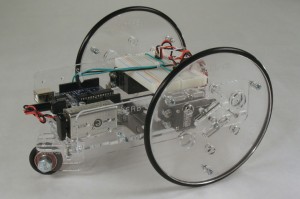
Two exciting robots based on Arduino have recently appeared: the RobotShop Robot Rover Development Platform and Oomlout’s Arduino Controlled Servo Robot (SERB). They’re both all-in-one kits and look like very capable machines. SERB has the advantage of being open-source, with PDF downloads for making your own chassis on a laser cutter or scroll saw (see the instructions on Instructables).
Happy robot-ing!
GOLDEN CHERUBIM CARRYING AN ARDUINO BOARD
– November 15th, 2008
Just cannot keep this thing to myself no more. My collaborators at 1scale1.comhave been running this year’s course in Physical Prototyping at K3, Malmo University, Sweden. I have no pictures of the course’s result, only of the prize given to the Best Interaction Design Piece at the end of the show. David Sjunnesson sent it to me while I am lecturing in Argentina (more about the country of beef on this blog soon).
The prize consisted of a golden cherubim carrying one of the early Arduino Serial boards on his head. I am sorry I missed the celebration, it must have been a funny one.
(c) 2008, picture by Sjunnesson



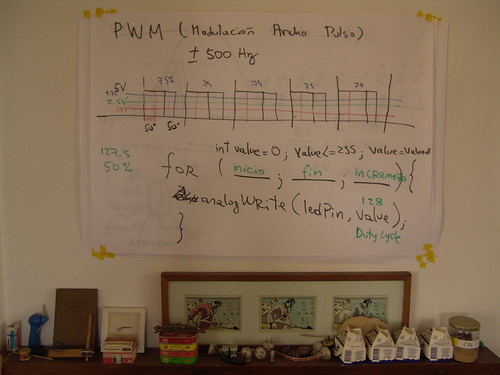
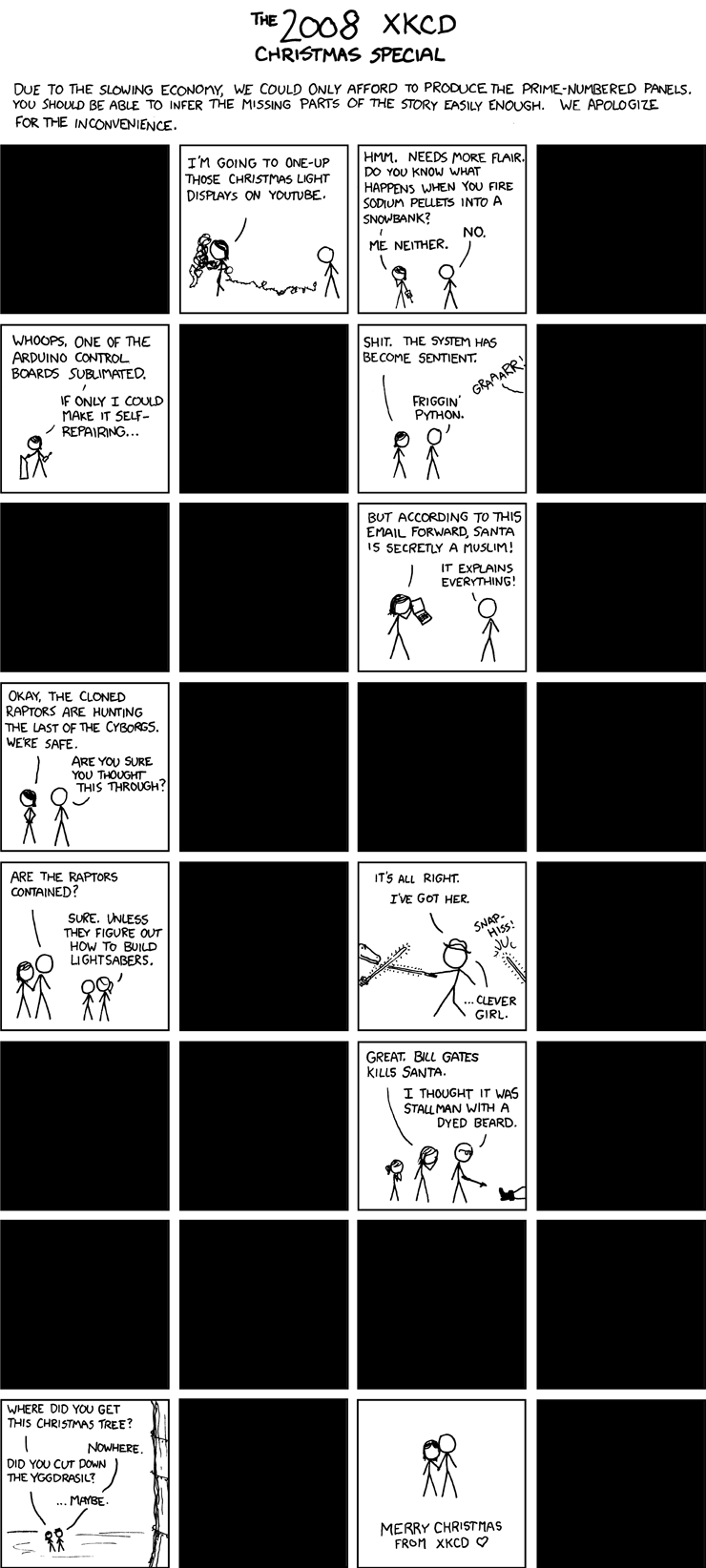

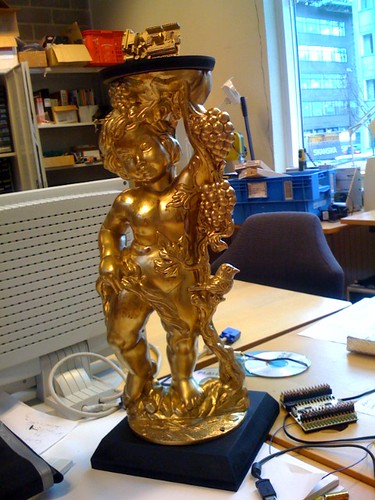






0 comentarios:
Publicar un comentario